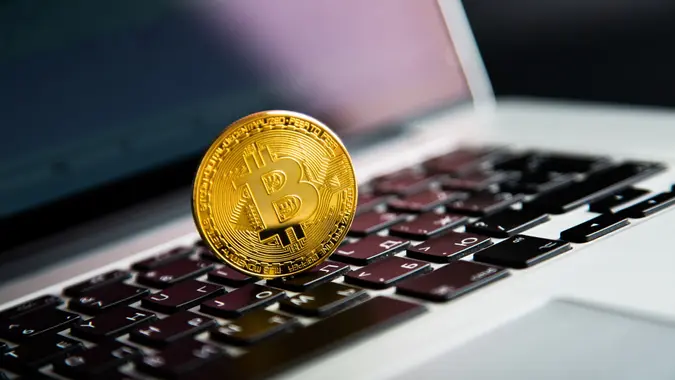What Is Bitcoin Mining? A Simple Explanation

Commitment to Our Readers
GOBankingRates' editorial team is committed to bringing you unbiased reviews and information. We use data-driven methodologies to evaluate financial products and services - our reviews and ratings are not influenced by advertisers. You can read more about our editorial guidelines and our products and services review methodology.

20 Years
Helping You Live Richer

Reviewed
by Experts

Trusted by
Millions of Readers
Bitcoin and other cryptocurrencies use a process called mining to validate transactions and to create new coins on their decentralized blockchain networks.
Bitcoin miners perform essential maintenance that ensures the integrity and security of the blockchain network. They create new Bitcoins while verifying and recording transactions simultaneously. For their efforts, the network rewards them with some of the Bitcoins their efforts generate.
How Does Bitcoin Mining Work?
Bitcoin mining is a process that rewards independent operators with specialized skills and computers for providing essential blockchain maintenance.
Proof of Work (PoW)
Bitcoin miners compete to solve complex mathematical puzzles as part of a blockchain consensus mechanism called proof-of-work (PoW). Successful miners verify and record transactions in inalterable and cryptographically linked data sets called blocks, which serve as transparent and permanent entries in a decentralized ledger.
The Bitcoin Mining Process
The Bitcoin mining process is a complex series of events that involves unfamiliar concepts and jargon like Merkle root, hash rates and nonce, all of which are beyond the scope of this article. The following is a simplified breakdown of the Bitcoin mining process.
- Verify a transaction
- Create a new block
- Solve a PoW puzzle
- Earn network validation
- Add the block to the blockchain
- Reward the miner or miners
- Repeat the process
Types of Bitcoin Mining
There are three primary Bitcoin mining strategies.
- Solo Mining: Solo miners compete to earn entire block rewards and transaction fees for themselves. While the potential payoff is high, working alone makes solving a given block much more unlikely for solo miners using their own resources and hardware to compete against an entire network.
- Pool Mining: Miners increase their odds of solving a given block when they pool their resources, hardware and efforts. The tradeoff for more frequent rewards is that mining pools must divide the spoils according to each miner’s contributions.
- Cloud Mining: Cloud miners can bypass the substantial costs and knowledge requirements associated with owning, operating and maintaining sophisticated mining hardware by purchasing mining contracts from mining operations companies. The downside is their fees can be steep, earnings volatility can be high and scams are common.
Hardware Needed for Bitcoin Mining
- ASIC Miners: Application-specific integrated circuit (ASIC) miners are specialty computer chips designed to solve cryptographic puzzles more effectively than the CPUs and GPUs they’ve largely replaced. They have achieved widespread adoption among professional miners and mining operations. Top players include Bitman, MicroBT and Canaan.
- GPU Mining: The graphics processing units that power GPU mining can be more flexible than highly specialized ASIC hardware and can be repurposed for mining different cryptocurrencies or for uses beyond mining altogether. However, purpose-built ASICs offer superior performance and efficiency. GPU mining still works for some altcoins but is no longer suitable for mining Bitcoin.
- Mining Rigs: Mining rigs are computers outfitted with multiple GPUs or ASIC miners to increase their capacity to solve mathematical puzzles. The primary concerns are how much computational power the rig can generate, the amount of energy it consumes and the cost, which can range from $2,000 to $15,000 or more.
Bitcoin Mining Difficulty
Bitcoin mining difficulty refers to the level of challenge miners face in solving puzzles and completing blocks. The network adjusts its mining difficulty every 2,016 blocks — about every two weeks — to adapt to changing network performance and maintain a consistent completion time of approximately 10 minutes per block.
If miners start taking more than 10 minutes to complete a block, the network reduces the difficulty. If they start completing them in less time, the network makes it harder to complete a block. When the difficulty increases, more miners need more computing power to solve the same problem, which can create income volatility.
How Bitcoin Mining Is Rewarded
The network rewards miners with block subsidies, which are specific portions of newly minted Bitcoins. The current subsidy is 3.125 BTC per block. Every 210,000 blocks — or roughly every four years — a so-called Bitcoin halving reduces the subsidy by 50%. The original subsidy was 50 BTC before halving began.
- Nov. 28, 2012: The first halving event cuts the subsidy from 50 to 25 BTC
- July 9, 2016: The second halving event reduces it to 12.5 BTC
- May 11, 2020: The third halving event lowers the reward to 6.25 BTC
- April 20, 2024: The fourth halving event reduces the subsidy to its current 3.125 BTC
Miners also earn transaction fees, which become increasingly important as block rewards diminish over time. Miners naturally choose transactions that pay higher fees, which ensures more important transactions take priority.
Bitcoin Mining and Energy Consumption
Bitcoin mining requires a high level of computational power and energy consumption by design — the effort, equipment and electricity that goes into it prevents bad actors from manipulating the blockchain.
However, that built-in security also creates a built-in flaw.
According to Polytechnique Insights, Bitcoin miners consume as much energy every year as Poland and use 660,000 Olympic-sized swimming pools worth of water.
Revelations about Bitcoin’s environmental impact spurred the crypto industry away from PoW mining and toward proof-of-stake (PoS) consensus, which uses crypto deposits instead of energy-intensive mining to validate blockchain transactions.
The Economics of Bitcoin Mining
The high start-up hardware expenses, ongoing energy costs, intense global competition, extreme volatility of Bitcoin prices and periodic halving events make it infeasible for most individuals and casual mining pools to profit from Bitcoin mining today as they were able to before.
Online mining profitability calculators can help you determine your earning potential.
The Future of Bitcoin Mining
Two of the primary differences between Bitcoin and traditional fiat currency are its finite supply and halving events, which ensure the deflationary design that makes it so appealing to crypto enthusiasts.
While the halving timeline is not fixed, Gemini expects the next halving to happen on March 26, 2028, when miners will earn subsidies of 1.56 BTC instead of the current 3.125. Most projections predict the last Bitcoin will be mined in 2140, leaving miners to profit only from transaction fees thereafter.
As hardware becomes increasingly specialized and powerful, the increased difficulty will require new innovations and remedies for Bitcoin’s status as a notorious energy hog. The Crypto Council for Innovation reports that many mining operations are transitioning to renewable energy sources like wind and solar to reduce their carbon footprint and lower costs, while many traditional mining operations have consolidated in countries like China where environmental regulations are comparatively lax.
FAQ
- What is the best hardware for Bitcoin mining?
- Application-specific integrated circuit (ASIC) miners are the gold standard for modern mining. High-end ASIC devices can cost $15,000.
- Can I mine Bitcoin without expensive equipment?
- Yes, you can rent the ability to validate blockchain transactions by purchasing cloud mining contracts, but the fees can be high enough to negate most of your earnings.
- How much Bitcoin can I mine in a day?
- There are currently 6.25 BTC in a block and blocks take roughly 10 minutes to mine. Your capacity, however, will depend on your skill, hardware and pool size.
- What is the role of a mining pool?
- Mining pools are groups of miners who combine their resources to increase their odds of completing blocks and then splitting the rewards they earn.
- Is Bitcoin mining still profitable in 2025?
- Bitcoin mining is no longer profitable for most individual miners and small pools.
- Can I mine Bitcoin on my computer?
- Most computers rely on a single central processing unit (CPU), which is not sufficient for the complexity and power required to mine Bitcoin.
 Written by
Written by  Edited by
Edited by 

























